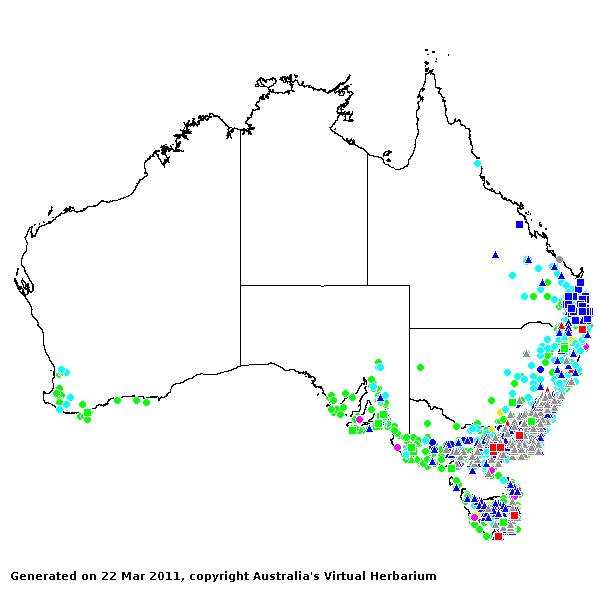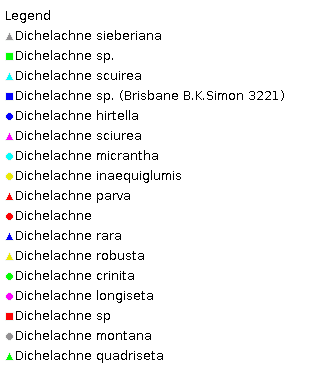Dichelachne Prodr. Fl. Norfolk. 20 (1833).
Derivation:. From Greek dichelos (split) and achne (glume), referring to the 2-lobed flowering glume.
Taxonomic revisions, nomenclatural references:. J.F.Veldkamp, Blumea 22: 5–12 (1974); E.Edgar and H.E.Connor, New Zealand Journal of Botany 20: 303–309 (1992); S.W.L.Jacobs, K.L.McClay & B.K.Simon, Telopea 5: 325–328 (1993).
Key references (keys and floras):. G.Bentham, Flora Australiensis 7: 573–575 (1878); C.A.Gardner, Flora of Western Australia 1 Gramineae 150–151 (1952); E.E.Henty, Manual Grasses New Guinea 72 (1969); J.C.Tothill and J.B.Hacker, Grasses of Southern Queensland 190–191 (1983); J.P.Jessop, Flora of South Australia 4: 1920–1921 (1986); B.K.Simon, Key to Australian Grasses 99 (1993); S.W.L.Jacobs and K.L.McClay, Flora of New South Wales 4: 582–584 (1993); N.G.Walsh, Flora of Victoria 2: 491–495 (1994); D.I.Morris, Student's Flora of Tasmania 4B: 276–280 (1994); E.Edgar and H.E.Connor, Flora of New Zealand 5: 255–262 (2000); D.Sharp and B.K.Simon, AusGrass (2002); J.P.Jessop, Grasses of South Australia 214–218 (2006); S.W.L.Jacobs, R.D.B.Whalley & D.J.B.Wheeler, Grasses of New South Wales, 4th Ed, 208–211 (2008); A.Wilson (ed.), Flora of Australia 44A: Poaceae 2: 214–221 (2009).
W.D.Clayton & S.A.Renvoize, Genera Graminum (1986), genus (204).
Native. 10 species, from Australia, New Zealand, New Guinea, Timor and the Pacific. 10 species in Australia, WA, SA, Qld, NSW, Vic, and Tas. Also New Guinea, Malesia and New Zealand.
Habit. Perennial, tufted. Leaf blades narrow. Ligule an unfringed membrane.
Inflorescence. Inflorescence paniculate, a spike-like panicle, contracted.
Spikelets. Spikelets laterally compressed, 1 flowered, with 1 fertile floret, awned, pedicelled; minutely with naked rachilla extension, or with rachilla terminating in a floret. Fertile spikelets disarticulating above glumes.
Glumes. Glumes unequal to more or less equal, (the upper) long relative to adjacent lemmas (longer or slightly shorter than the floret), pointed (acuminate), awnless, keeled or non-keeled, similar (hyaline to membranous). Lower glume 1 nerved. Upper glume 1 nerved.
Florets. Fertile florets 1. Lemmas linear to narrowly lanceolate, involute, decidedly firmer than glumes (the main distinction from Agrostis), not becoming indurated (thinly leathery), entire at apex or incised (tending to split), awned, faintly 5 nerved, glabrous. Awns 1, from a sinus or dorsal or apical, non-geniculate or geniculate, usually recurving, much longer than body of lemma (usually 1.5–3 cm long). Palea relatively long, entire (acute), 2 nerved. Callus short, blunt. Stamens 1–3. Grain small, longitudinally grooved, compressed dorsiventrally. Hilum short, or long-linear. Embryo small.
Kranz Anatomy. C3.
2n = 70, 10 ploid.
Habitat. Mesophytic, xerophytic. Forest margins and upland grasslands. Species of open habitats.
Classification. Pooideae; Poeae.
Notes. A small homogeneous genus often mistaken for (Austro)stipa, but the subapical awn and liquid endosperm point to a relationship with Calamagrostis (Deyeuxia). It differs from the latter in its fusiform florets, short callus hairs and long wavy awn (Clayton and Renvoize, 1986).
Types Species. D. montana Endl.
Biogeographic Element. Clifford & Simon 1981, Simon & Jacobs 1990: Australasian.


